 /r2 central force applied.
In intro physics our topic is the motion of planets under the influence of the Sun's gravitational
force...orbital mechanics. Then
/r2 central force applied.
In intro physics our topic is the motion of planets under the influence of the Sun's gravitational
force...orbital mechanics. Then
Orbital Motion: motion of a particle with a  /r2 central force applied.
In intro physics our topic is the motion of planets under the influence of the Sun's gravitational
force...orbital mechanics. Then
/r2 central force applied.
In intro physics our topic is the motion of planets under the influence of the Sun's gravitational
force...orbital mechanics. Then
 =GMm
=GMm
where G is Newton's gravitational constant: 6.6726 × 10-11 m3·kg-1·s-2, M is the mass of the central object object (which might be the Sun with mass 1.9889 × 1030 kg or Earth with mass 5.9737 × 1024 kg) and m is the mass of the orbiting object.
Note that in atomic physics the motion of an electron under the influence of the
electrostatic attractive force of the nucleus has equivalent equations for the force (and hence "the same"
as far a physics goes) but quite different distance scales. (The constant  would then depend on the electric charge of the nucleus and of the electron and Coulomb's constant
that plays the role of G in the electrostatic force equation.)
would then depend on the electric charge of the nucleus and of the electron and Coulomb's constant
that plays the role of G in the electrostatic force equation.)
Planets move in ellipses with the Sun at one focus. Ellipses can be described in terms of their semi-major axis, a, (basically the longest radius) and their eccentricity (basically how squashed the ellipse is: e=0 is a circle, a fully squashed ellipse looks like a line and has e=1).
r=a(1-e2)/(1+e cos( ));
rmin= a(1-e); rmax=a(1+e)
));
rmin= a(1-e); rmax=a(1+e)
 , the polar angle from closest approach is given the odd name:
true anomaly. The timing of the motion (i.e., when the planet has
a particular
, the polar angle from closest approach is given the odd name:
true anomaly. The timing of the motion (i.e., when the planet has
a particular  ) is a bit complex. The game is to express the
true anomaly (
) is a bit complex. The game is to express the
true anomaly ( ) in terms of the eccentric anomaly (u)
and then find an expression relating time and the eccentric anomaly. For nearly
circular orbits it turns out that the true anomaly, the eccentric anomaly, and the
mean anomaly (
) in terms of the eccentric anomaly (u)
and then find an expression relating time and the eccentric anomaly. For nearly
circular orbits it turns out that the true anomaly, the eccentric anomaly, and the
mean anomaly ( t) are all approximately
equal to each other. I apologize for this archaic nomenclature, but physics is stuck with these
names. Below find the geometric construction that relates the true anomaly and the eccentric anomaly,
the formula relating these two, and the formula relating time and the
eccentric anomaly.
t) are all approximately
equal to each other. I apologize for this archaic nomenclature, but physics is stuck with these
names. Below find the geometric construction that relates the true anomaly and the eccentric anomaly,
the formula relating these two, and the formula relating time and the
eccentric anomaly.
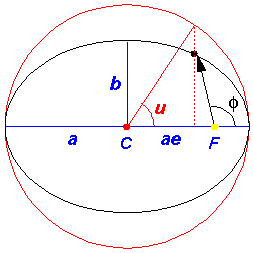


In the above picture, the yellow dot represents the Sun; it is at a focus (F) of the ellipse. The red parts of the diagram have to do with the geometric construction for the eccentric anomaly which is measured from the center (C) of the ellipse. There is nothing physically at the center of the ellipse, this is all just part of a geometric construction. The blue parts of the diagram relate the semi-major axis (a) and the distance between the ellipse center and the focus (ae). The semi-minor axis, b, can be related to the semi-major axis and the eccentricity:
b = a(1-e2)½
The black ellipse is the orbit of the particle, i.e., the set
of positions the particle will traverse during a period
(T=2 /
/ ).
).
It is most convenient to express the position of the particle in terms of u. The vector r giving the x and y positions of the planet (with the Sun at the origin) is given by:
r = ( a(cos(u)-e), a (1-e2)½ sin(u) )
Now for any u we can find the time the planet was at that location using Kepler's equation:

We can similarly find  for that u from:
for that u from:

The velocity vector is, of course, changing as the position vector is changing. The set of velocities the particle will have during a period is called the hodograph; it's just like an orbit, but for velocity rather than position. The hodograph is surprising: it's just a circle, but the center of the circle is not v=0.
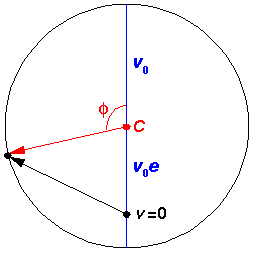

Note that at closest approach to the Sun ( =0) the speed is a maximum
and the velocity points in the y direction, whereas at the far point
(
=0) the speed is a maximum
and the velocity points in the y direction, whereas at the far point
( =180°) the speed is a minimum
and the velocity points in the -y direction. As the eccentricity
approaches 1, the maximum speed gets arbitrarily large and the minimum speed
approaches zero.
=180°) the speed is a minimum
and the velocity points in the -y direction. As the eccentricity
approaches 1, the maximum speed gets arbitrarily large and the minimum speed
approaches zero.
The above figures have been drawn with a rather large eccentricity: e=.707. For eccentricities similar to those of the planets it would be hard to distinguish the elliptical orbit from a circle (although for some planets--like Mars--the position of the Sun would look noticeably "off-center"...because the Sun is at a focus rather than the center).
If the (attractive) radial force is given by:
Fr=- /r2, the
potential energy is U(r)=-
/r2, the
potential energy is U(r)=- /r,
so that the minus derivative of U is
the force. Notice that just like the spring
(U(x)=½k x2, which also attracts to the origin), the potential
energy is ever smaller as you approach the origin. Unlike the spring, this potential energy is
numerically negative (i.e., U(r)<0).
That is a result of our choice of additive constant. For the spring we choose the potential
to be zero at the origin, forcing the potential to be arbitrarily big as x approaches infinity.
For this problem we take the potential energy to be zero as r approaches infinity, so the potential
at the origin must be infinitely less, i.e., negative infinity.
The seemingly over-complex geometric description of motion:
/r,
so that the minus derivative of U is
the force. Notice that just like the spring
(U(x)=½k x2, which also attracts to the origin), the potential
energy is ever smaller as you approach the origin. Unlike the spring, this potential energy is
numerically negative (i.e., U(r)<0).
That is a result of our choice of additive constant. For the spring we choose the potential
to be zero at the origin, forcing the potential to be arbitrarily big as x approaches infinity.
For this problem we take the potential energy to be zero as r approaches infinity, so the potential
at the origin must be infinitely less, i.e., negative infinity.
The seemingly over-complex geometric description of motion:



can, with some work, be seen to solve the equation of motion:

Start by noting that the velocity vector is made of a constant
vector (ev0j)
added to the red rotating vector. Taking the time derivate removes
the constant from consideration, so the acceleration vector must
be tangent to the circle--i.e., rotated 90° from the red radial
vector, which is itself rotated 90° from r (note
that the zero for  was the x-axis for
the orbit and the y-axis in the hodograph). Thus
the acceleration vector is in the right direction: -r.
The magnitude of the acceleration vector is just:
was the x-axis for
the orbit and the y-axis in the hodograph). Thus
the acceleration vector is in the right direction: -r.
The magnitude of the acceleration vector is just:

 is related to the
(constant) angular momentum (L) [which we can
evaluate for example, at the near point].
is related to the
(constant) angular momentum (L) [which we can
evaluate for example, at the near point].

Solving the above for  and substituting
into our equation for the magnitude of the acceleration vector, yields:
and substituting
into our equation for the magnitude of the acceleration vector, yields:
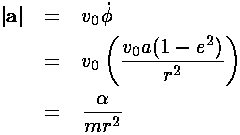
Note in passing that if the angular momentum is zero, then e=1. The circular orbits (e=0) have the maximum possible angular momentum for a given semi-major axis a, that is for a given energy E because there is a simple relation between the semi-major axis a and E:

Note that the energy is negative; the positive kinetic energy equals (on average) one half the absolute value of the potential energy and the result is that the total energy is ½ the average potential energy.
Here is another way of presenting the results: plots displaying the position of the particle on the orbit and the velocity of the particle on the hodograph at a series of equally spaced times.
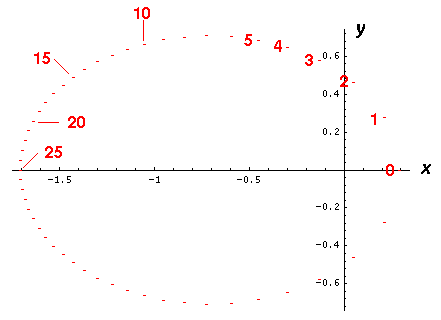
The above is a plot of the (x,y) location of a planet at successive increments of time (tics) Note the when the planet is close to the Sun, the planet seems to move a great distance between tics, whereas when the planet is is far from the origin, it seems to move only a little between tics. This is exactly what you would expect for a particle conserving angular momentum (i.e., following Kepler's second law of constant areal velocity).
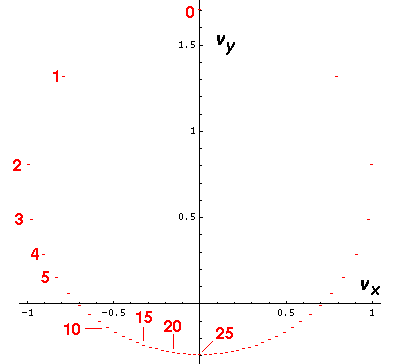
The above is a plot of the (vx,vy) velocity of a planet at successive increments of time (tics) Note the when the planet is close to the Sun (e.g., near tic 0) the velocity seems to change quite a bit between tics, whereas when the planet is is far from the origin (e.g., near tic 25), the velocity seems to change only a little between tics. This is exactly what you should expect for a 1/r2 force.
Note that the motion is confined to a plane so we can display the results on a flat screen.
If we ignore the angular part of the motion, we can make plots of the the radial velocity vs. time (in tics), the distance from the origin (r) vs. time, and the speed (v) vs. time:
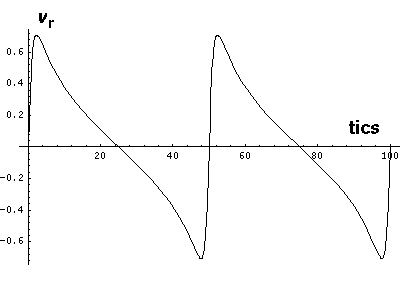
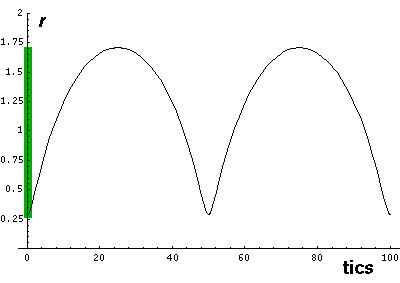
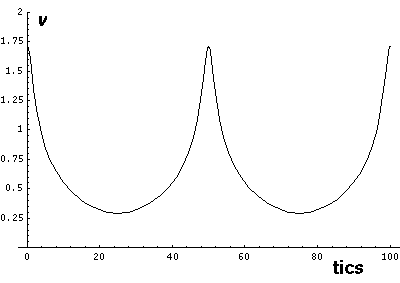
Note that r seems to "bounce" off the minimum radius rmin. The motion is in fact quite similar to the bouncing falling ball. Here vr changes quickly (but not instantaneous) between negative (falling) and positive (rising) values. The green area on the r plot shows the classically allowed region.
Note that while r does range between two values: rmin= a(1-e) & rmax=a(1+e), these turning points are a bit different from 1-d turning points as v is never zero. We can, however, threat our 3-d (reduced to 2-d) motion as a 1-d motion in an effective potential (see for example, Marion p.301, Barger & Olsson p.138, Goldstein p.61) which includes the centrifugal potential:

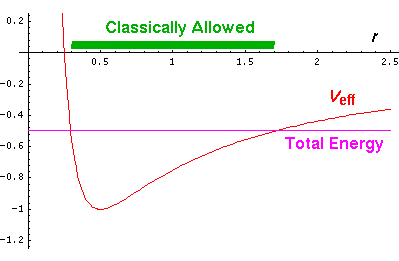
The above diagram plots various the energies involved as a function of r. The line representing "Total Energy" is flat, because total energy is conserved (i.e., is constant). Total energy is the sum of kinetic energy and potential energy. We can decompose kinetic energy (½mv2) into two pieces by using the Pythagorean theorem to decompose v2 into the sum of two terms: radial velocity squared (vr2) and the component of velocity perpendicular to r ("transverse" velocity) squared. The "transverse" kinetic energy, can be calculated from the angular momentum and r...the result is the centrifugal potential. The centrifugal potential has been added to the 1/r potential; the result is plotted in red. Thus total energy is the sum of the effective potential and the "radial" kinetic energy. At the turning points there is zero "radial" kinetic energy, and the radial velocity is zero (i.e., the particle is no longer moving in or out: r is either at a minimum or a maximum). We note that for orbital motion, the time to complete a radial oscillation :
(i.e., rmin rmax
rmax rmin)
is also the time it takes to go around the Sun
(i.e., for
rmin)
is also the time it takes to go around the Sun
(i.e., for  to increase by 2
to increase by 2 ).
).